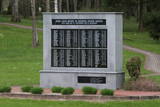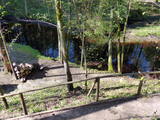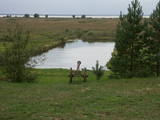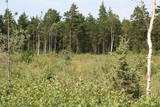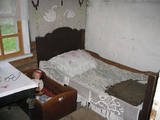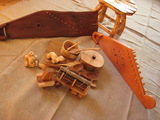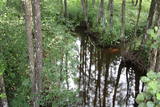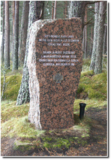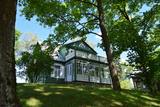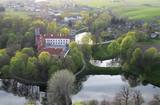| Nr | Name | Beschreibung |
|---|---|---|
|
Madonas ainavai zināmu šarmu piešķir Leivērītes un Madonas upītes gravas, kuru atsevišķiem posmiem doti dažādi nosaukumi. Mīlestības gravas krasti ir iecienīta pilsētnieku pastaigu un atpūtas vieta. Gravas nogāzē aiz 2. vidusskolas ieslēpusies "Lazdu laipa", kas pazīstama no rakstnieces (šejienes novadniece) Ilzes Indrānes romāniem. Parka dīķī esošo strūklaku uzskata par Latvijā augstāko. Mīlestības gravas turpinājums ir Laulības un Šķiršanās grava. |
||
|
This is an unusually shaped pine which, according to legend, was planted by the king of Sweden during the Great Northern War.
|
||
|
In der Zeit des Zweiten Weltkrieges – Ende des Septembers im Jahr 1944 spielte sich in More eine von der blutigsten und grausamsten Kämpfe im Territorium Lettlands ab. Noch grausamer waren nur die Kämpfe im sogenannten „Kessel von Kurland” (Kurzemes katls). In der Kämpfen von More haben die auf der Seite Deutschlands kämpfenden lettischen Legionäre den Durchbruch der Roten Armee nach Riga verhindert, als auch die Einkreisung des deutschen Truppenteils 18 abgewehrt. Das Resultat der Kämpfe war wichtig für die örtliche Bevölkerung, (> 100 000), die Menschen könnten noch fliehen und solcherweise der späteren Repressionen entfliehen. Jedes Jahr wird hier im September Gedenkfeier gefeiert. Hier sammeln sich sowohl Augenzeuge dieser Vorgänge, als auch andere Interessenten. Hier wurde eine Memorialwand mit Namen der Legionäre, als auch einen in Stein gemeißelten Kreuz – das Gedenkzeichen für alle nicht identifizierten Gefallenen aufgestellt. 2 km östlich von dem Park ist ein Museum eingerichtet. Neben diesem Museum kann man einen sowjetischen Panzer besichtigen.
|
||
|
Pie Gārsenes pils atrodas bijušais muižas parks 4ha platībā un pie tā sākas arī Gārsenes dabas takas. Dabas takas vēsturiski tika veidotas vienlaicīgi ar pils kompleksa būvniecību un ieeja takās atrodama pie mākslīgi veidotā, ar bruģa pamatni izliktā barona peldēšanās dīķa. Takas sākumā saglabājusies ošu aleja, ko savulaik stādījis barona dārznieks, savukārt taku vidusposmā apmeklētājiem ir iespēja pasēdēt uz Barona krēsla - akmens ar cilvēku veidotu sēdvietu tajā. Kopumā Gārsenes mežā vijas dažāda garuma labiekārtotas pastaigu un izziņas takas - Kultūrvēsturiskā taka, Zaļā taka, Baronu pastaigu taka, Staburaga taka, ar ierīkotām atpūtas un ugunskuru vietām. Takās apskatāmi vairāk kā 40 unikāli dabas objekti, gan dižakmeņi, gan dižkoki, kā arī un pagasta ievērojamākie arhitektūras un kultūrvēstures pieminekļi. No 2016.gada maija Dabas takās ietilpst arī „Krēslas stundas taka”, kas īpaši patiks zinātkāriem mazajiem ceļotājiem. Taka stāsta par Rūķu dzīvi mežā un tās veidošanas pamatā ir stāsti no „Lielās Rūķu enciklopēdijas”. |
||
|
Mit den Teichen von Nagļu sind das Lettlands größte Fischteiche. Sie wurden 1970 in den Auenwiesen des Sees Lubāns eingerichtet, als zuerst das Wasserkraftwerksystem des Sees geschaffen wurde. Die Straße Lubāna-Gaigalava teilt die Kvāpāni-Īdeņa-Teiche. Es gibt auf den Teichdämmen drei Vogelbeobachtungstürme. Diese Teiche sind ein wichtigster Nistraum für Wasservögel sowie Rastplätze während des Vogelzugs. Hier gibt es viele Vogelbeobachtungsmöglichkeiten.
|
||
|
Das Wirtshaus befindet sich im historischen Zentrum von Jekabpils an dem Damm des Flusses Daugava. Es zeichnet sich durch sein Angebot an exotischen Speisen aus. Lettische Küche: Käsesalat, Steinpilzsuppe, Topf mit Hähnchen- oder Schweinfleisch, Erdbeersuppe mit Eis. |
||
|
Das Café Pärnamäed befindet sich an der Landstraße Via Baltica 10 km von Pärnu in Richtung Riga. Es spezialisiert sich auf Süßwaren, das Backen von Weißbrot und Schwarzbrot ohne Konservierungsstoffe und bietet auch Produkte verschiedener Kleinproduzenten an. Das Café bietet auch Suppen, Hauptgerichte und Desserts an. |
||
|
Similar as Alsungas mezi (Alsunga forests) – is not intended and appropriate for visits. A narrow path of the restricted area can be seen from the gravel road – Saka-Apriki. Nature restricted area established mainly for protection of Erica tetralix (often called "cross-leaved heath") and it is one of the most important growing places.
|
||
|
Der älteste Teil der jetzigen Wohnriege ist die Riegenstube mit dem Erdfussboden aus 19.Jh. Das Wohnzimmer mit Kammern wurde in der II. Hälfte des XIX. Jahrhunderts gebaut. |
||
|
Der Hof Obelynė [„Apfelhof“] von Tadas Ivanauskas wird als museale Gedenkstätte in Ringaudai, Landkreis Kaunas, betrieben. Derzeit besteht der Hof aus dem Wohnhaus als Museum, dem Gartenhaus und dem Geflügelstall, einem etwa 4 ha großen Obstgarten und Park. Die Bezeichnung der Örtlichkeit stammt von den hier an den Hängen reichlich blühenden und tragenden Holzäpfeln und Weißdornbüschen. |
||
|
This is a view worth a journey from a distance. This is an impressive terrain for Latvia, and here you will see as far as the Hanja highlands of Estonia, where the Great Munameģis Hill – the highest surface in the Baltic States – can be found.
|
||
|
Auf der à la carte Speisekarte des Restaurants wird der Schwerpunkt auf qualitatives Wildfleisch gelegt. Fischgourmets werden im Teich Sangaste Loss frisch geangelte Sibirische Störe angeboten. Damit wird sichergestellt, dass die Produkte immer frisch sind. Hoch geschätzt werden alte Zubereitungsverfahren, z. B. Backen über dem Feuer im natürlichen Rauch. |
||
|
Guntis Niedoliņš is a master craftsman, and at this workshop he manufactures wooden jewellery, furniture, interior design objects, spoons, shovels, etc. |
||
|
The craftsman uses experimental archaeological methods to produce the jewellery of ancient Baltic tribes. He will tell you about their symbolism, meaning and wearing traditions. You can tour the workshop and purchase jewellery that has been made there. |
||
|
Dieses Gebiet befindet sich auf beiden Seiten des mittleren Abschnitts des Flusses Raķupe. An den Ufern des Flusses gibt es sowohl viele verschiedene Wiesenbiotope als auch mächtige Eichen. Das ist ein wichtiger Platz für seltene Pflanzen und Tiere.
|
||
|
Der Gedenkplatz der Kämpfe der
finnischen Jäger in Klapkalnciems. Nach
dem Ersten Weltkrieg wurde 1929 hier ein
Denkmal für fünf gefallene finnische
Soldaten aufgestellt. In der Sowjetzeit
wurde dieser zerstört und im Mai 2004 neu
aufgestellt. Im Museum von Lapmežciems
kann man Fotos sehen und mehr
Information über die finnischen Jäger
erfahren.
|
||
|
Die museale Gedenkstätte für A. Baranauskas und A. Vienuolis-Žukauskas wurde 1927 begründet. Hier wird Material gesammelt, archiviert und gezeigt, welches die Kultur und Literatur der Gegend um Anykščiai, die Geschichte, die Entwicklung von Landwirtschaft und Technik in der Region zeigt. Die Besucher können das ganze Jahr über durch die Hügel des Schriftstellergedächtnisparks spazieren. |
||
|
Der Name Ainaži ist untrennbar von der lettischen Seefahrtsgeschichte. Im Jahr 1864 wurde hier die erste Seefahrtsschule gegründet, in der auch die Kinder der lettischen Bauern lernen konnten. Es ist gesetzmäßig, dass Ainaži zu einem bedeutenden Zentrum für den Bau von Schiffen für Küstenschifffahrt und zu einem Hafen wurde. Das wirtschaftliche Leben der Stadt hat die im Jahr 1913 eröffnete Schmalspurbahnlinie Smiltene-Valmiera-Ainaži begünstigt. Heute ist die Stadt Ainaži eine kleine und stille lettische Stadt, die mit mehreren interessanten Sehenswürdigkeiten an der Grenze zu Estland liegt. |
||
|
Gebaut in 1610, später umgebaut. Eins der hervorragenden Gebäuden Litauens der Renaissance. Eine Ausstellung der Kunstakademie Vilnius. Ein Aussichtsturm. |
||
|
Die wichtigste Erscheinung des Waldes von Sasaļi ist der eutrophische See Sasalis, sowie der ungewöhnliche See Melnezers. Von bedeutung sind auch die verschiedenen Waldtypen des Gebietes. Der See Sasalis ist ein beliebter Platz für die Erholung und zum Schwimmen.
|
||


